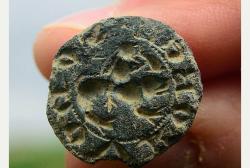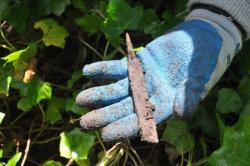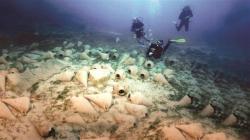INSTITUT SUPERIEUR D'ANTHROPOLOGIE
INSTITUTE OF ANTHROPOLOGY
ONLINE COURSES / COURS A DISTANCE
FALL TERM : OCTOBER 2014
REGISTER NOW
ROYAUME UNI –  Lufton - A seal used to decorate wax as it secured medieval letters has been discovered in the first week of an archaeological dig. The artefact - thought to have been used between AD 1250 and 1400 - was discovered buried in a field off Thorne Lane as part of an excavation led by Dr James Gerrard. The inscription reads SOhOV ROBEN and the picture shows a hare riding a hound and blowing a hunting horn. Mr Gerrard, formerly of Yeovil, said: “This is an exciting discovery and an example of medieval humour or wit. “Sohov is an Anglicised French hunting call like 'tally-ho' and Roben is a typical French name for a dog during the period - like Fido or Rover. “The design ironically references the nobility's love of hunting. It mocks this favoured pursuit by reversing the normal order of things, with the hare being the hunter.” It may have been used by women or members of the clergy. The area focuses on land south to where a late Roman villa – dating from between AD 250 to 400 – was excavated by Leonard Hayward in the 1950s and 1960s. A study also indicated the presence of an Iron Age settlement which pre-dates the villa. The project was launched five years ago to discover more about Roman life in the town, and the history of the deserted medieval settlement at Lufton. It is the third year a dig has taken place.
Lufton - A seal used to decorate wax as it secured medieval letters has been discovered in the first week of an archaeological dig. The artefact - thought to have been used between AD 1250 and 1400 - was discovered buried in a field off Thorne Lane as part of an excavation led by Dr James Gerrard. The inscription reads SOhOV ROBEN and the picture shows a hare riding a hound and blowing a hunting horn. Mr Gerrard, formerly of Yeovil, said: “This is an exciting discovery and an example of medieval humour or wit. “Sohov is an Anglicised French hunting call like 'tally-ho' and Roben is a typical French name for a dog during the period - like Fido or Rover. “The design ironically references the nobility's love of hunting. It mocks this favoured pursuit by reversing the normal order of things, with the hare being the hunter.” It may have been used by women or members of the clergy. The area focuses on land south to where a late Roman villa – dating from between AD 250 to 400 – was excavated by Leonard Hayward in the 1950s and 1960s. A study also indicated the presence of an Iron Age settlement which pre-dates the villa. The project was launched five years ago to discover more about Roman life in the town, and the history of the deserted medieval settlement at Lufton. It is the third year a dig has taken place.
http://www.westerngazette.co.uk/Medieval-letter-seal-discovered-archaeological/story-21938569-detail/story.html
USA –  Bainbridge Island - Archaeologists may soon begin excavating the site of a south Bainbridge village that teemed with Japanese immigrants a century ago. The Bainbridge Island Historical Museum is partnering with Olympic College and The Kitsap County Historical Society and Museum on a plan for the first intensive archeological survey and excavation at Yama, a village that had its heyday in the 1890s and burned down in the 1920s. The hillside site, which overlooks Blakely Harbor Park, was never redeveloped, leaving many artifacts in "perhaps the best-preserved Japanese immigrant village site in the Pacific Northwest," said Robert Drolet, an OC archaeology professor leading the project. Yama and the adjacent neighborhood of Nagaya made up the largest and most distinct immigrant settlement that grew along the outskirts of Port Blakely, a lumber mill and shipbuilding town that has all but vanished from the shores of Blakely Harbor. Port Blakely also drew populations of Hawaiians, Scandinavians, Chinese, Italians and Basques. With a population of around 300, Yama supported a hotel with a Japanese-style bathhouse, Buddhist temple, Baptist church and a general store with an ice cream parlor, photography studio and tea garden. While no buildings remain, the site is dotted with fragments of pottery, glass and metal. Recovered artifacts and explorations of buried garbage dumps may reveal new information about how Yama's inhabitants carried on their Japanese traditions while adapting to life in America, Drolet said.
Bainbridge Island - Archaeologists may soon begin excavating the site of a south Bainbridge village that teemed with Japanese immigrants a century ago. The Bainbridge Island Historical Museum is partnering with Olympic College and The Kitsap County Historical Society and Museum on a plan for the first intensive archeological survey and excavation at Yama, a village that had its heyday in the 1890s and burned down in the 1920s. The hillside site, which overlooks Blakely Harbor Park, was never redeveloped, leaving many artifacts in "perhaps the best-preserved Japanese immigrant village site in the Pacific Northwest," said Robert Drolet, an OC archaeology professor leading the project. Yama and the adjacent neighborhood of Nagaya made up the largest and most distinct immigrant settlement that grew along the outskirts of Port Blakely, a lumber mill and shipbuilding town that has all but vanished from the shores of Blakely Harbor. Port Blakely also drew populations of Hawaiians, Scandinavians, Chinese, Italians and Basques. With a population of around 300, Yama supported a hotel with a Japanese-style bathhouse, Buddhist temple, Baptist church and a general store with an ice cream parlor, photography studio and tea garden. While no buildings remain, the site is dotted with fragments of pottery, glass and metal. Recovered artifacts and explorations of buried garbage dumps may reveal new information about how Yama's inhabitants carried on their Japanese traditions while adapting to life in America, Drolet said.
http://www.kitsapsun.com/news/local-news/bainbridge-islander/archaeological-dig-planned-for-immigrant-village-site-on-bainbridge_92188426
BULGARIE –  Vratsa - it is the town of Vratsa in north-western Bulgaria that is getting into the act, after the excitement of claims around a so-called vampire in June 2012 in the seaside resort of Sozopol, followed by one in Veliko Turnovo, and with Perperikon – already famous for a trove of legitimate discoveries – not being outdone by finding a “twin” of the vampire in September 2013. Bulgarian-language media reports said that a medieval vampire burial site had been found during excavations of an ancient fortress near Vratsa. Unlike the previously well-known method of disposing of vampires by driving a stake through the heart, the funeral ritual of the “Vampire of Vratsa”, as local media are somewhat giddily terming it, involved a boulder from the mountain. Settlement of the area of Gradishteto in Vratsa dates back at least to the Thracians. On this steep cliff, later came a Roman fortress and then a medieval village. At the site, archaeologists have found the grave of an elderly man of a unusually tall height for the time, 1.8 metres. The burial site testifies to the special treatment of the deceased. On his heart, archaeologists found a deliberately placed processed white stone, said to be part of rituals against vampirism. Archaeologist Alexandra Petrova told Bulgarian National Television that placing a stone on the chest, notably the left side where the heart is, was part of such a practice, that could also involve stabbing with a stake or iron knife. The aim was to prevent the deceased’s return to the world of the living, which in turn also could be done by putting a pet cat or chicken across the body. Such rituals would be carried out if the deceased was a stranger to the community, or loner or who had no one to watch over him at night. Another reason could be if the man, while alive, had been evil, thus prompting precautions against him coming back to cause mischief. In the case near Vratsa, there was apparently double insurance. This involved tying the feet to make the dead stumble if trying to return to the world of the living. Excavations in the Gradishteto area are continuing, the report said, with archaeologists hoping to find other graves to see if the “Vampire of Vratsa” is an isolated case or whether this was a special local funeral ritual.
Vratsa - it is the town of Vratsa in north-western Bulgaria that is getting into the act, after the excitement of claims around a so-called vampire in June 2012 in the seaside resort of Sozopol, followed by one in Veliko Turnovo, and with Perperikon – already famous for a trove of legitimate discoveries – not being outdone by finding a “twin” of the vampire in September 2013. Bulgarian-language media reports said that a medieval vampire burial site had been found during excavations of an ancient fortress near Vratsa. Unlike the previously well-known method of disposing of vampires by driving a stake through the heart, the funeral ritual of the “Vampire of Vratsa”, as local media are somewhat giddily terming it, involved a boulder from the mountain. Settlement of the area of Gradishteto in Vratsa dates back at least to the Thracians. On this steep cliff, later came a Roman fortress and then a medieval village. At the site, archaeologists have found the grave of an elderly man of a unusually tall height for the time, 1.8 metres. The burial site testifies to the special treatment of the deceased. On his heart, archaeologists found a deliberately placed processed white stone, said to be part of rituals against vampirism. Archaeologist Alexandra Petrova told Bulgarian National Television that placing a stone on the chest, notably the left side where the heart is, was part of such a practice, that could also involve stabbing with a stake or iron knife. The aim was to prevent the deceased’s return to the world of the living, which in turn also could be done by putting a pet cat or chicken across the body. Such rituals would be carried out if the deceased was a stranger to the community, or loner or who had no one to watch over him at night. Another reason could be if the man, while alive, had been evil, thus prompting precautions against him coming back to cause mischief. In the case near Vratsa, there was apparently double insurance. This involved tying the feet to make the dead stumble if trying to return to the world of the living. Excavations in the Gradishteto area are continuing, the report said, with archaeologists hoping to find other graves to see if the “Vampire of Vratsa” is an isolated case or whether this was a special local funeral ritual.
http://sofiaglobe.com/2014/07/27/archaeology-bulgarias-vampire-of-vratsa/
TURQUIE –  Muğla’s Datça - A group of researchers from İzmir’s Dokuz Eylül University’s Institute of Marine Science and Technology (IMST), who conduct research on sunken ships located between Muğla’s Datça peninsula and Antalya, have discovered eight new sunken ships. The institute’s deputy director Associate professor Harun Özdaş said the first stage of the Aegean and Mediterranean research had been finished in 2004, adding: “The main purpose of the project is to expand the inventory of sunken ships. From the beginning of this year, we have been focusing on the ships that sank during the Ottoman times. During three months of research, we discovered eight new sunken ships.:It was a very productive time as we worked in the areas where we hadn’t previously worked before.” Özdaş added that the sunken ships, which have already been revealed, would be given to the Bodrum Museum of Underwater Archaeology in the coming days.
Muğla’s Datça - A group of researchers from İzmir’s Dokuz Eylül University’s Institute of Marine Science and Technology (IMST), who conduct research on sunken ships located between Muğla’s Datça peninsula and Antalya, have discovered eight new sunken ships. The institute’s deputy director Associate professor Harun Özdaş said the first stage of the Aegean and Mediterranean research had been finished in 2004, adding: “The main purpose of the project is to expand the inventory of sunken ships. From the beginning of this year, we have been focusing on the ships that sank during the Ottoman times. During three months of research, we discovered eight new sunken ships.:It was a very productive time as we worked in the areas where we hadn’t previously worked before.” Özdaş added that the sunken ships, which have already been revealed, would be given to the Bodrum Museum of Underwater Archaeology in the coming days.
http://www.hurriyetdailynews.com/new-sunken-ships-discovered-in-aegean-.aspx?pageID=238&nid=69664&NewsCatID=375
IRLANDE – Lurgankeel - A Norman mote found at Lurgankeel, Kilcurry in July, 1964 was the first of its kind to be examined thoroughly by the National Monuments Commission in the Republic. The extensive archaeological excavation over seven weeks established the fort was occupied until some time in the 14th century. Occupation ceased about that time and there were no traces of other inhabitants until the 19th century. Among the valuable finds were pottery, iron arrow heads, and a knife blade and rowel which were dated back to the 13trh century. The excavations also uncovered a second mote about 40 feet from the principal one which was described as rather unique by the Commission. The moats were outposts used in the Norman period to hold occupied territory and usually were within sight of others. The Lurgankeel one was in line with the vision of Castletown mount, Castle Roche Mount and would have been visible from the top of the wooden building of the period. Referred to as Moat Albani in Wright's Louthlana, published in 1748, the Lurgankeel site got its name from a tenant of De Verdon early in the 13th century and was possible built by De Courcey around 1176 on his lighting raid into Co. Down. It would have been occupied up until about the time of Edward Bruce.
http://www.independent.ie/regionals/argus/news/norman-mote-found-in-kilcurry-30452641.html